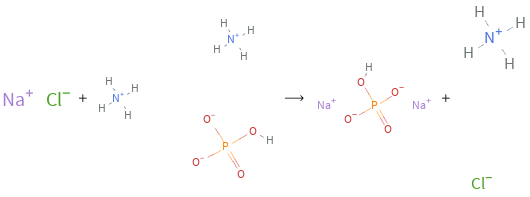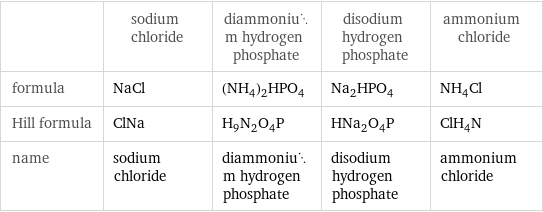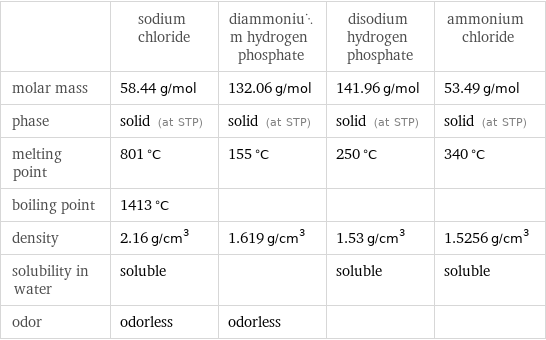Input interpretation

NaCl sodium chloride + (NH_4)_2HPO_4 diammonium hydrogen phosphate ⟶ Na_2HPO_4 disodium hydrogen phosphate + NH_4Cl ammonium chloride
Balanced equation

Balance the chemical equation algebraically: NaCl + (NH_4)_2HPO_4 ⟶ Na_2HPO_4 + NH_4Cl Add stoichiometric coefficients, c_i, to the reactants and products: c_1 NaCl + c_2 (NH_4)_2HPO_4 ⟶ c_3 Na_2HPO_4 + c_4 NH_4Cl Set the number of atoms in the reactants equal to the number of atoms in the products for Cl, Na, H, N, O and P: Cl: | c_1 = c_4 Na: | c_1 = 2 c_3 H: | 9 c_2 = c_3 + 4 c_4 N: | 2 c_2 = c_4 O: | 4 c_2 = 4 c_3 P: | c_2 = c_3 Since the coefficients are relative quantities and underdetermined, choose a coefficient to set arbitrarily. To keep the coefficients small, the arbitrary value is ordinarily one. For instance, set c_2 = 1 and solve the system of equations for the remaining coefficients: c_1 = 2 c_2 = 1 c_3 = 1 c_4 = 2 Substitute the coefficients into the chemical reaction to obtain the balanced equation: Answer: | | 2 NaCl + (NH_4)_2HPO_4 ⟶ Na_2HPO_4 + 2 NH_4Cl
Structures

+ ⟶ +
Names

sodium chloride + diammonium hydrogen phosphate ⟶ disodium hydrogen phosphate + ammonium chloride
Reaction thermodynamics
Enthalpy

| sodium chloride | diammonium hydrogen phosphate | disodium hydrogen phosphate | ammonium chloride molecular enthalpy | -411.2 kJ/mol | -1567 kJ/mol | -1748 kJ/mol | -314.4 kJ/mol total enthalpy | -822.4 kJ/mol | -1567 kJ/mol | -1748 kJ/mol | -628.8 kJ/mol | H_initial = -2389 kJ/mol | | H_final = -2377 kJ/mol | ΔH_rxn^0 | -2377 kJ/mol - -2389 kJ/mol = 12.4 kJ/mol (endothermic) | | |
Equilibrium constant
![Construct the equilibrium constant, K, expression for: NaCl + (NH_4)_2HPO_4 ⟶ Na_2HPO_4 + NH_4Cl Plan: • Balance the chemical equation. • Determine the stoichiometric numbers. • Assemble the activity expression for each chemical species. • Use the activity expressions to build the equilibrium constant expression. Write the balanced chemical equation: 2 NaCl + (NH_4)_2HPO_4 ⟶ Na_2HPO_4 + 2 NH_4Cl Assign stoichiometric numbers, ν_i, using the stoichiometric coefficients, c_i, from the balanced chemical equation in the following manner: ν_i = -c_i for reactants and ν_i = c_i for products: chemical species | c_i | ν_i NaCl | 2 | -2 (NH_4)_2HPO_4 | 1 | -1 Na_2HPO_4 | 1 | 1 NH_4Cl | 2 | 2 Assemble the activity expressions accounting for the state of matter and ν_i: chemical species | c_i | ν_i | activity expression NaCl | 2 | -2 | ([NaCl])^(-2) (NH_4)_2HPO_4 | 1 | -1 | ([(NH4)2HPO4])^(-1) Na_2HPO_4 | 1 | 1 | [Na2HPO4] NH_4Cl | 2 | 2 | ([NH4Cl])^2 The equilibrium constant symbol in the concentration basis is: K_c Mulitply the activity expressions to arrive at the K_c expression: Answer: | | K_c = ([NaCl])^(-2) ([(NH4)2HPO4])^(-1) [Na2HPO4] ([NH4Cl])^2 = ([Na2HPO4] ([NH4Cl])^2)/(([NaCl])^2 [(NH4)2HPO4])](../image_source/305fafb24be2309bc68b2cd56575cd03.png)
Construct the equilibrium constant, K, expression for: NaCl + (NH_4)_2HPO_4 ⟶ Na_2HPO_4 + NH_4Cl Plan: • Balance the chemical equation. • Determine the stoichiometric numbers. • Assemble the activity expression for each chemical species. • Use the activity expressions to build the equilibrium constant expression. Write the balanced chemical equation: 2 NaCl + (NH_4)_2HPO_4 ⟶ Na_2HPO_4 + 2 NH_4Cl Assign stoichiometric numbers, ν_i, using the stoichiometric coefficients, c_i, from the balanced chemical equation in the following manner: ν_i = -c_i for reactants and ν_i = c_i for products: chemical species | c_i | ν_i NaCl | 2 | -2 (NH_4)_2HPO_4 | 1 | -1 Na_2HPO_4 | 1 | 1 NH_4Cl | 2 | 2 Assemble the activity expressions accounting for the state of matter and ν_i: chemical species | c_i | ν_i | activity expression NaCl | 2 | -2 | ([NaCl])^(-2) (NH_4)_2HPO_4 | 1 | -1 | ([(NH4)2HPO4])^(-1) Na_2HPO_4 | 1 | 1 | [Na2HPO4] NH_4Cl | 2 | 2 | ([NH4Cl])^2 The equilibrium constant symbol in the concentration basis is: K_c Mulitply the activity expressions to arrive at the K_c expression: Answer: | | K_c = ([NaCl])^(-2) ([(NH4)2HPO4])^(-1) [Na2HPO4] ([NH4Cl])^2 = ([Na2HPO4] ([NH4Cl])^2)/(([NaCl])^2 [(NH4)2HPO4])
Rate of reaction
![Construct the rate of reaction expression for: NaCl + (NH_4)_2HPO_4 ⟶ Na_2HPO_4 + NH_4Cl Plan: • Balance the chemical equation. • Determine the stoichiometric numbers. • Assemble the rate term for each chemical species. • Write the rate of reaction expression. Write the balanced chemical equation: 2 NaCl + (NH_4)_2HPO_4 ⟶ Na_2HPO_4 + 2 NH_4Cl Assign stoichiometric numbers, ν_i, using the stoichiometric coefficients, c_i, from the balanced chemical equation in the following manner: ν_i = -c_i for reactants and ν_i = c_i for products: chemical species | c_i | ν_i NaCl | 2 | -2 (NH_4)_2HPO_4 | 1 | -1 Na_2HPO_4 | 1 | 1 NH_4Cl | 2 | 2 The rate term for each chemical species, B_i, is 1/ν_i(Δ[B_i])/(Δt) where [B_i] is the amount concentration and t is time: chemical species | c_i | ν_i | rate term NaCl | 2 | -2 | -1/2 (Δ[NaCl])/(Δt) (NH_4)_2HPO_4 | 1 | -1 | -(Δ[(NH4)2HPO4])/(Δt) Na_2HPO_4 | 1 | 1 | (Δ[Na2HPO4])/(Δt) NH_4Cl | 2 | 2 | 1/2 (Δ[NH4Cl])/(Δt) (for infinitesimal rate of change, replace Δ with d) Set the rate terms equal to each other to arrive at the rate expression: Answer: | | rate = -1/2 (Δ[NaCl])/(Δt) = -(Δ[(NH4)2HPO4])/(Δt) = (Δ[Na2HPO4])/(Δt) = 1/2 (Δ[NH4Cl])/(Δt) (assuming constant volume and no accumulation of intermediates or side products)](../image_source/88575906077e856adf7e65c1af671fec.png)
Construct the rate of reaction expression for: NaCl + (NH_4)_2HPO_4 ⟶ Na_2HPO_4 + NH_4Cl Plan: • Balance the chemical equation. • Determine the stoichiometric numbers. • Assemble the rate term for each chemical species. • Write the rate of reaction expression. Write the balanced chemical equation: 2 NaCl + (NH_4)_2HPO_4 ⟶ Na_2HPO_4 + 2 NH_4Cl Assign stoichiometric numbers, ν_i, using the stoichiometric coefficients, c_i, from the balanced chemical equation in the following manner: ν_i = -c_i for reactants and ν_i = c_i for products: chemical species | c_i | ν_i NaCl | 2 | -2 (NH_4)_2HPO_4 | 1 | -1 Na_2HPO_4 | 1 | 1 NH_4Cl | 2 | 2 The rate term for each chemical species, B_i, is 1/ν_i(Δ[B_i])/(Δt) where [B_i] is the amount concentration and t is time: chemical species | c_i | ν_i | rate term NaCl | 2 | -2 | -1/2 (Δ[NaCl])/(Δt) (NH_4)_2HPO_4 | 1 | -1 | -(Δ[(NH4)2HPO4])/(Δt) Na_2HPO_4 | 1 | 1 | (Δ[Na2HPO4])/(Δt) NH_4Cl | 2 | 2 | 1/2 (Δ[NH4Cl])/(Δt) (for infinitesimal rate of change, replace Δ with d) Set the rate terms equal to each other to arrive at the rate expression: Answer: | | rate = -1/2 (Δ[NaCl])/(Δt) = -(Δ[(NH4)2HPO4])/(Δt) = (Δ[Na2HPO4])/(Δt) = 1/2 (Δ[NH4Cl])/(Δt) (assuming constant volume and no accumulation of intermediates or side products)
Chemical names and formulas

| sodium chloride | diammonium hydrogen phosphate | disodium hydrogen phosphate | ammonium chloride formula | NaCl | (NH_4)_2HPO_4 | Na_2HPO_4 | NH_4Cl Hill formula | ClNa | H_9N_2O_4P | HNa_2O_4P | ClH_4N name | sodium chloride | diammonium hydrogen phosphate | disodium hydrogen phosphate | ammonium chloride
Substance properties

| sodium chloride | diammonium hydrogen phosphate | disodium hydrogen phosphate | ammonium chloride molar mass | 58.44 g/mol | 132.06 g/mol | 141.96 g/mol | 53.49 g/mol phase | solid (at STP) | solid (at STP) | solid (at STP) | solid (at STP) melting point | 801 °C | 155 °C | 250 °C | 340 °C boiling point | 1413 °C | | | density | 2.16 g/cm^3 | 1.619 g/cm^3 | 1.53 g/cm^3 | 1.5256 g/cm^3 solubility in water | soluble | | soluble | soluble odor | odorless | odorless | |
Units
